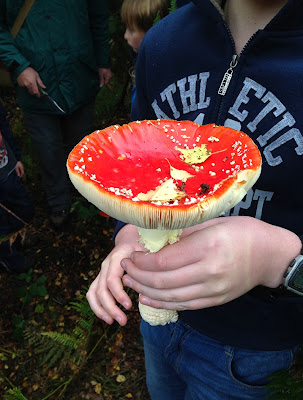We had an excellent fungal foray in St Ives Estate on Sunday 13th October. The weather was perfect for fungi... because it was damp! But that didn’t put off a large group of us eager to see what fungi we could uncover.
For fungal expertise we welcomed back Bob Taylor of the Sports Turf Research Institute at St Ives. Before setting off, Bob took a few minutes to share his enthusiasm for the natural world and to ‘raise the veil’ on the basics of mycology – the study of fungi.
We learned that fungi are an essential part of the natural process that breaks down fallen leaves and wood to release their nutrients back into the soil. We also learnt that many fungi have close associations with particular trees. Some fungi, called mycorrhizal fungi, work together with plants, with each giving the other access to their ‘food’ - this kind of cooperation is called symbiosis.
Bob explains how to identify fungi
In preparation for us starting our hunt, Bob showed us the different parts of a mushroom. which would help us identify them. Experts say that there are up to 15,000 known species of fungus in the UK, but many more remain unknown to science. Bob also showed us how to carefully pick fungi i a way that causes the least damage. Then it was off into the woods!
The first fungus was spotted at our feet, before we had even moved! That set a trend, and the group ferried fungi to Bob for identification in a constant cycle. We all quickly learned to identify Honey Fungus, Earth Balls, Fairies Bonnets, coconut-scented Milk Caps and the “classic Gnome’s companion” Fly Agaric. Fortunately Bob was on-hand to advise us with the more exotic finds, like the radish-scented, red parasol fungi called The Deceiver, a tiny sooty-grey and black club-fungus called Candle Snuff, and a startlingly bright orange finger fungus called Yellow Antler. We also found a rare club fungus, called the Pipe Club (Clavariadelphus fistulosus), which Bob took home to identify.
What we didn’t do was get very far – there were too many fungi at every step – in the grass, on tree stumps, in the leaves and even some growing on other fungi!
Candle Snuff fungus (Xylaria hypoxylon)
The rare Pipe Club fungus (Clavariadelphus fistulosus) - found by an Airedale Otter!
A fungus growing on another fungus (with some moss too)
Honey Fungus (Armillaria sp.)
Honey Fungus growing on an Oak tree
Purple Jelly fungus (Ascocoryne sarcoides)
Bob also fixed a few parasol mushrooms on to card for people to take away. These can be left overnight, allowing many of the tiny spores to fall out of the mushroom’s gills and build up lines of colour on the card, leaving a ‘spore print’ (which can be ‘fixed’ with hairspray of artists' fixative).
Bob shows us how to make spore prints
One of the the Honey Fungus spore prints we made
Pressing on, we moved onto the path to Lady Blantyre’s rock, collecting large displays of Sulphur Tuft at the base of trees, Candle Snuff, Ugly Milk Cap (Lactarius turpis), Brown Birch Bolete, and many more. We also collected a huge Brown Birch Bracket fungus weighing nearly a kilogram!
Learning about the huge Brown Birch Bracket fungus (Piptoporus betulinus)
No fungi foray would be complete without finding a Fly Agaric (Amanita muscaria)
As we reached the end of the walk a couple of people walked past with carrier bags of mushrooms they had picked for the table – so we weren’t the only ones out looking for mushrooms!
Thank you to everyone who braved the weather and we hope you enjoyed it as much as we did.














No comments:
Post a Comment